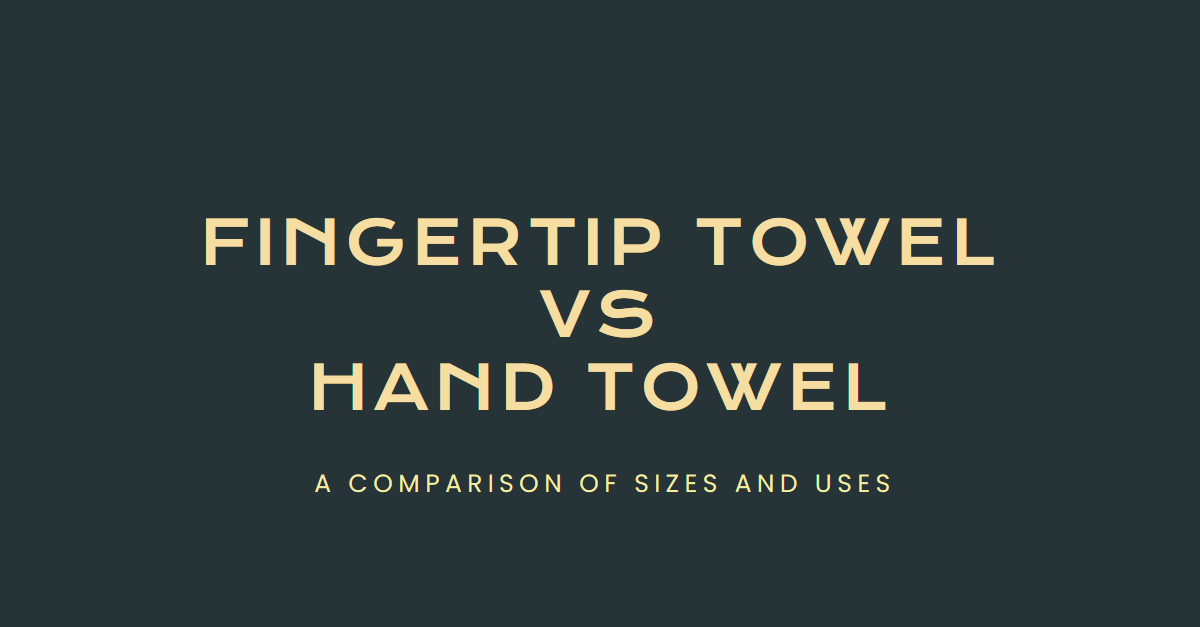Fingertip and hand towels are two common types of towels that serve different purposes. Fingertip towels are small, compact squares while hand towels are larger rectangular towels. Many people are confused about when and why you should use each type.
This article provides detailed information about fingertip and hand towels. It explains the main differences, suggests suitable uses for each, and helps you decide which towel is best for you.
What is a Fingertip Towel?
A fingertip towel is a small towel, usually measuring around 11 by 18 inches. It is designed for drying our hands and fingers after washing. Usually, it’s made of light material like cotton that dries fast. They can have a basic solid color or simple pattern.

The main uses of fingertip towels include:
- Drying fingers or hands after washing.
- Wiping glasses or other delicate items.
- Gently dabbing and cleaning the face.
- Quick clean-ups of small spills.
| Pros | Cons |
|---|---|
| Compact size takes up less space | Less absorbent due to smaller thin size |
| Dries quickly | Need frequent replacement as they wear faster |
| Versatile for finger drying, glasses, gentle face tasks | Not suitable for heavy-duty cleaning/drying |
| Affordable compared to larger towels |
Fingertip towels are designed to be versatile and easy to use for light cleaning tasks requiring a small towel. Their compact size makes them easy to hang within reach in a bathroom or kitchen.
What is a Hand Towel?
A hand towel is a larger rectangular-shaped towel measuring approximately 16 x 30 inches. It has multiple uses beyond drying hands. Hand towels are made from absorbent fabric like cotton, microfiber, linen, or terry cloth. They often come in decorative colors and patterns to match your bathroom decor.

The primary uses of hand towels include:
- Drying hands after washing.
- Wiping up spills on counters and tables.
- Quick clean-ups of larger messes.
- General multi-purpose cleaning tasks.
| Pros | Cons |
|---|---|
| Highly absorbent for drying hands and cleaning | Bulkier and take up more space |
| Standard versatile size for multi-purpose use | Take longer to dry out than fingertip towels |
| More durable than fingertip towels | More expensive than fingertip towels |
Hand towels are designed for drying and cleaning hands and other surfaces that need a bigger, more absorbent towel. You often see them in kitchens, bathrooms, and workshops.
Key Differences Between Fingertip and Hand Towels
| Factor | Fingertip Towel | Hand Towel |
|---|---|---|
| Size | 11 by 18 inches | 15 x 25 to 18 x 30 inches |
| Absorbency | Less absorbent due to small size | More absorbent due to a larger surface area |
| Use Cases | Good for hands, face, and body | Drying hands, Cleaning spills |
| Portability | Compact and portable | Bulkier and less portable |
| Cost | Typically more affordable | Higher cost on average |
| Materials | Usually cotton | Cotton, linen, microfiber |
| Durability | Wear out faster | More durable and thicker |

Factors to Consider When Choosing Between Them
When deciding between fingertip and hand towels, here are some factors to take into account:
- Intended use – Will the towel be used for drying fingers and faces or drying hands and cleaning spills? Fingertip towels work better for delicate tasks while hand towels are preferable for heavy-duty drying and cleaning jobs.
- Location – Will the towel go in the bathroom by the sink for facial tasks or in the kitchen for frequent hand drying? Fingertip towels usually make the most sense in bathrooms.
- Absorbency needs – Do you need a towel that is thin and dries quickly like a fingertip towel, or something thicker and more absorbent like a hand towel?
- Decor – Do you need a towel to match existing decor in your home? Both come in a variety of colors and patterns.
- Budget – Fingertip towels are generally more affordable because they use less material. Hand towels cost more but tend to last longer.
Additional Tips for Both Towels
Washing
- Wash towels frequently to prevent buildup of dirt and bacteria.
- Avoid using fabric softener as it can reduce absorbency.
Drying
- Air dry towels or tumble dry on a low setting to avoid damaging materials.
- Make sure towels are fully dry before re-using to prevent mildew.
Storing
- Hang towels on hooks rather than stuffing in drawers so they can dry.
- Store in open containers and avoid tight sealing for ventilation.
Replacing
- Replace fingertip towels often as they wear out faster.
- Hand towels may last longer with proper care.
Conclusion
In short, fingertip and hand towels have different purposes because they vary in size, absorbency, and durability. Fingertip towels are for drying fingers and delicate tasks, while hand towels are good for heavy-duty hand drying and cleaning tasks.
When choosing between the two, think about your specific needs and preferences. Both can be handy to have in your home.
Additional Resources
Frequently Asked Questions
What can you do with fingertip towels?
Fingertip towels are versatile and handy for tasks such as drying your hands or fingers after washing, wiping delicate items like glasses, gently cleaning the face, and quick clean-ups of small spills.
Where do fingertip towels go?
Fingertip towels are typically placed in bathrooms, near sinks, or in kitchens for easy access. Their compact size makes them suitable for use in areas where space is limited.
What is the size of a fingertip towel?
Fingertip towels are generally small, measuring around 11 by 18 inches. This compact size is designed for specific tasks like hand and finger drying, as well as other light cleaning activities.

